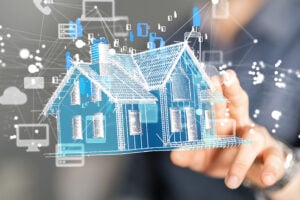At the risk of sounding like I am nearing retirement age (ahem, I still have some 30 years to go!), when I got my first job in the late nineties in Uttar Pradesh in...
How IoT lays the foundations for the buildings of the future
3 mins read
Ask someone what they think the building of the future looks like and many will describe something alien-like, oddly shaped and possibly even floating in the air. But you don’t have to be a time traveller to catch a glimpse of what the future holds...
With their fully glazed exteriors, the Edge in Amsterdam and Berlin’s 10-storey Cube look like many other recently constructed corporate offices, but both offer a sneak peek into what many buildings of the future might look like – both inside and out. The two buildings are covered in sensors that monitor what’s going on inside, from the environmental conditions to which parts are occupied at any given time, so lights and climate control systems can be adjusted accordingly. Employees have a dedicated mobile app that helps them to find a free desk or meeting space, gives them access to various facilities, and allows them to tweak the temperature and light levels around where they’ve chosen to work that day. Even entry to the car park is completely automated, with lighting that only illuminates the area when it senses a human presence. Combined with solar panels on the facades and roofs of surrounding buildings, the Edge uses 70 percent less electricity than a typical office premises. Going green while generating new revenue streams Leveraging the Internet of Things (IoT) to intelligently monitor how a building is used, combined with predictions based on weather and traffic conditions, allows building managers to anticipate the occupancy of the building on a day-by-day basis. This means catering staff can minimise waste, unused rooms can be skipped by the cleaners, and maintenance staff are warned in advance when repairs need to be made or office supplies need to be refilled. Buildings like these stand out right now because they’re the exception rather than the rule, but they give us an idea of what to expect from our schools, offices and other public premises in the future.
Leveraging the Internet of Things (IoT) to intelligently monitor how a building is used, combined with predictions based on weather and traffic conditions, allows building managers to anticipate the occupancy of the building on a day-by-day basis. This means catering staff can minimise waste, unused rooms can be skipped by the cleaners, and maintenance staff are warned in advance when repairs need to be made or office supplies need to be refilled. Buildings like these stand out right now because they’re the exception rather than the rule, but they give us an idea of what to expect from our schools, offices and other public premises in the future.
Enhancing a building’s connectivity also creates completely new opportunities for businesses. Through new data capture and management capabilities of IoT, traditional electronics manufacturers and facilities management companies get the chance to transform their business models. New offerings, such as heating-as-a-service or lighting-as-a-service, enable them to generate new revenue streams while providing their customers with more customised and intelligent services. The extra data generated through such systems allow companies to save money and reduce their carbon footprint without inconveniencing staff. As businesses’ green credentials come under increasing scrutiny, this data can be leveraged for environmental profit and loss reporting too."Soon all new buildings will intelligently monitor things like air quality and security, with IoT-enabled Building Management Systems getting more advanced as the amount of data generated goes up."
"The next step will be to expand the capabilities of connected buildings beyond their physical walls and connect with other buildings in the vicinity, joining up to the wider smart city infrastructure and IoT ecosystem."
 This will allow data to be used on a wider scale and enable the whole area to run more efficiently, rather than just individual premises. So, imagine driving to work, and as your connected car approaches the car park of the IoT-powered building, it will direct you to a free parking spot nearby, or alert you to a breakfast offer in the café in the lobby. If you’ll be the first to arrive, the air conditioning or heating on the floor will switch on from eco-mode to ensure you won’t be sweating or freezing as you take your seat.
Protecting connected buildings against cyber-threats
This will allow data to be used on a wider scale and enable the whole area to run more efficiently, rather than just individual premises. So, imagine driving to work, and as your connected car approaches the car park of the IoT-powered building, it will direct you to a free parking spot nearby, or alert you to a breakfast offer in the café in the lobby. If you’ll be the first to arrive, the air conditioning or heating on the floor will switch on from eco-mode to ensure you won’t be sweating or freezing as you take your seat.
Protecting connected buildings against cyber-threats
Hackers don’t have much to gain from accessing your bedside lamp, but if more sensitive corporate data can be stolen by hacking into a building’s heating or parking system, it becomes a very appealing target for cyber criminals, making security more important than ever before. The risk is two-fold which is why data must be protected both in motion (i.e. as it travels on an IoT network to the cloud and back) and at rest (i.e. within any connected device or ‘thing’). Private mobile networks, complemented by a global, virtual private mobile network with encrypted mobile-edge-to-cloud connectivity, help ensure the security and integrity of data across a range of applications, from a car to a connected building. But what about buildings that have been around since the 1800s? Incorporating smart, secure IoT technology is relatively easy when starting from scratch but older buildings weren’t designed to be fitted with the sensors and networks, and doing so isn’t always possible, particularly if the building in question is particularly historic."Of course, any increased attack surface, whether it’s a connected car, an entire building, or just your home’s handful of smart light bulbs, raises the risk of a breach."
 However, it’s not impossible. When New York City’s Empire State Building was completed in 1931 the Bakelite telephone was seen as cutting edge, but the skyscraper’s status as a prestige location for businesses has not waned as more modern buildings have sprung up around it. In order to address issues around intelligence and energy efficiency, the 102-storey building went through a $550m revamp, introducing a building management system that uses sensors to enable smart control over the climate and air quality based on the occupancy levels of specific areas. As a result, some offices within the building are
now comparable to newly built green buildings in terms of energy consumption.
However, it’s not impossible. When New York City’s Empire State Building was completed in 1931 the Bakelite telephone was seen as cutting edge, but the skyscraper’s status as a prestige location for businesses has not waned as more modern buildings have sprung up around it. In order to address issues around intelligence and energy efficiency, the 102-storey building went through a $550m revamp, introducing a building management system that uses sensors to enable smart control over the climate and air quality based on the occupancy levels of specific areas. As a result, some offices within the building are
now comparable to newly built green buildings in terms of energy consumption.
While a revamp the scale of the Empire State Building is a complex and costly undertaking, the returns on this investment are undeniable for building owners and managers, as well as businesses and people and the wider urban ecosystem. Digital transformation is the key to rebuilding our cities, no matter how old the foundations are. Read Kim's article on breaking down barriers for MVNOs in the IoT market."According to a 2019 report by US think tank the EraNova Institute, what holds many buildings back from becoming smarter is their over-reliance on paper to manage critical systems such as electricity, plumbing and air conditioning."
Leaders In Our Own Right
Explore related solution
The recent cyber-attack on Sony Pictures is a unique phenomenon of our time. Not only has it gone some way to tarnishing the careers of some A-list actors, it has...
This blog is the second in a two parter; you can read the first instalment, Self Driving Cars here. To provide some context, in mid-November I had the opportunity to...
What’s next?
Explore Our Solutions
Explore our solutions through immersive platform demos or engage with our surveys and pricing calculators
Explore Our Solutions
Explore our solutions through immersive platform demos or engage with our surveys and pricing calculators
Explore Our Solutions
Explore our solutions through immersive platform demos or engage with our surveys and pricing calculators


.png?width=310&height=159&name=image%20(1).png)